
International Research Journal of Engineering and Technology (IRJET) e-ISSN:2395-0056
Volume: 11 Issue: 09 | Sep 2024 www.irjet.net p-ISSN:2395-0072


International Research Journal of Engineering and Technology (IRJET) e-ISSN:2395-0056
Volume: 11 Issue: 09 | Sep 2024 www.irjet.net p-ISSN:2395-0072
Monika1 Umesh Kumar Sinha2
1Research Scholar, Department of Electrical and Electronics Engineering, B. I. T. Mesra, Ranchi, Jharkhand (India)
2Professor, Department of Electrical Engineering, National Institute of Technology Jamshedpur, India 831014, …………………. *** ………………………………………………………
Abstract-As time goes on, developments in technology occur dramatically. The Grey Wolf Optimized Control Methodology for Converter in Grid-Tied PV System is demonstrated in the present investigation. A new algorithm for an optimization problem develops every day. The present study implements an optimization-based Tuned PI controller, commonly referred to as the Grey Wolf Optimized (GWO) Algorithm, to improve power quality in a distribution system by means of converter control in a grid-tied photovoltaic system.TheMATLAB/SIMULINKenvironment isusedto model the complete system. Finally, this work highlights how a Grid Converter's GWO-tuned PI controller can improve power qualitybyminimizingTHD.
Keywords: Grey Wolf Optimization, PI Controller, Grid Tied Photovoltaic System, MATLAB/SIMULINK, STATCOM, Grid Converter, Duty Cycle.
1.INTRODUCTION
The energy sector is now an essential component of organizationforthewell-beingofnationsandisalsovitalfor economic development. The power sector in India is extremely changed. In India, conventional electricity production accounts for most power generation sources, with non-conventional generation seeing an increase in demand [1]– [5]. It is necessary to produce high-quality power since power generating is so important. However, there are various power quality problems because of the wide variety of loads. Power engineers and the power industry thus face a difficult problem when it comes to powerquality.Manytechniquesarebeingusedthesedaysto compensate for power quality [6]– [10]. This article uses a grid converter based on GWO as a compensator to improve powerquality.AshuntcompensatorcalledaGridConverter (STATCOM) receives its input from a PV system. The Grey Wolf Optimized (GWO) Algorithm based control technique fortheconverterinagrid-tiedphotovoltaicsystemhasbeen demonstrated in this study. A novel optimization technique is suggested for the STATCOM control system to fine-tune the PI Controller. Lastly, this work illustrates how a Grid
Converter's GWO-tuned PI controller can improve power qualitybyloweringTHD[10]–[15].
The GWO algorithm mimics the leadership hierarchy and hunting mechanism of grey wolves in nature. Four types of grey wolves such as alpha, beta, delta, and omega are employed. In addition to the social hierarchy of grey wolf’s pack hunting is another appealing societal action of grey wolves. The main segments of GWO are encircling, hunting andattackingprey.
The pseudo code of the GWO algorithm
InitializethegreywolfpopulationXi (i=1,2,...,n)
Initializea,A,andC
Calculatethefitnessofeachsearchagent
Xα=thebestsearchagent
Xβ=the second-best search agent Xδ=the third best search agent while (t < Max number of iterations) for each search agent
Updatethepositionofthecurrentsearchagent end for
Updatea,A,andC
Calculate the fitness of all search agents Update Xα, Xβ, andXδ t=t+1 end while returnXα

International Research Journal of Engineering and Technology (IRJET) e-ISSN:2395-0056
Volume: 11 Issue: 09 | Sep 2024 www.irjet.net p-ISSN:2395-0072
This work presents the Grey Wolf Optimized (GWO) algorithm-basedconvertercontrollertechniqueforgrid-tied photovoltaic systems. An entirely new optimization technique is suggested for the STATCOM control system to fine-tune the PI Controller. In MATLAB, a 100 KW photovoltaic grid system is simulated. Below is the Block Diagram.
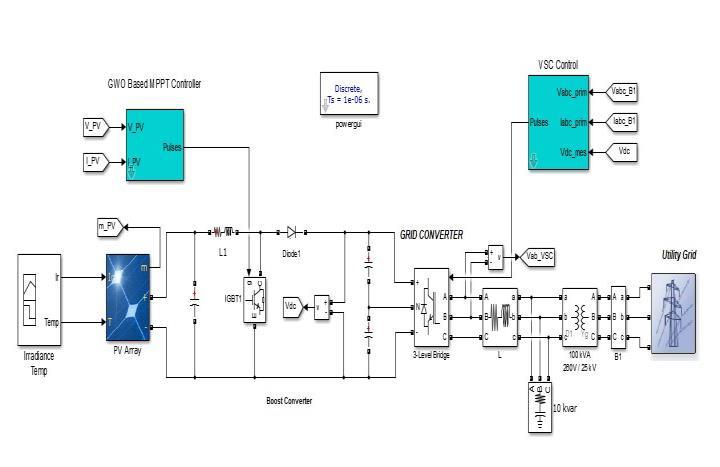
Fig-1: ProposedModelofGreyWolfOptimization(GWO) basedgridconverter
A grid converter's development is identical to that of a three-phase inverter. IGBTs are utilized in the Grid Converterasswitches. SinceIGBTSswitchesare completely regulated. Six IGBTs have been used in total, indicating that a Grid Converter has three arms altogether two switches for each arm [16]– [20]. This type has a 100 KW photovoltaic module connected to a 5 kHz 500 V boost converter,whichraisesthePVmodulevoltageto500Vand maintains it there no matter what. The Grid Tied Converter has been connected to the Boost Converter. The Voltage SourceConverter(level3)inthismodel3iscategorizedasa grid converter. The boost converter's constant 500 V DC voltage is transmitted to the grid converter. Through a 100 KVA transformer, the Grid Converter is connected to the UtilityGrid.
ThreeCaseswithVariableTemperatureandIrradiancehave been employed to test the proposed model. The two differentpossibilitieshavebeenshownbelow.
Case1:PSObasedonGridconverter
Case2:GWObasedonGridConverter
TemperatureandIR radiationarethetwovariablesusedto testeachofthetwoinstances,i.e.,
Case 1: PSO based Grid Converter:
Inthissituation,thePIcontroller'sgaintheparametershave beenusedwiththeaidofthePSOoptimizedtechnique.Since the gain values are tuned values for the PSO algorithm, we can say that the controller is tuned by the PSO algorithm since the PI controller produces the optimum output with theaidoftheoptimizedgainvalue.Theassociatedoutcomes arepresentedbelow:
This figure displays the variable temperature and variable irradiance. Mean Power, Duty Cycle, and Mean Voltage. The dutycycleoscillations,meanpower,andmeanvoltageexits. ThePVmodule'soutputpoweris273.5Vwhenoperatingat 1000 W/m2 at 25 degrees Celsius, which is the maximum powerof100.7KW.ThePVmodule'soutput poweris265.1 Vwhenoperatingat250W/m2at25degreesCelsius,which isthemaximumpowerof24.4KW.Themaximumpowerat 1000 W/m2 and 50 degrees Celsius is 92.9 KW, and under these circumstances, the PV module's output power is 92.9kW. The PV module's maximum power at 1000 W/m2 and 50 degrees Celsius is 92.9 KW, and its output power is 250.2Vunderthesecircumstances.
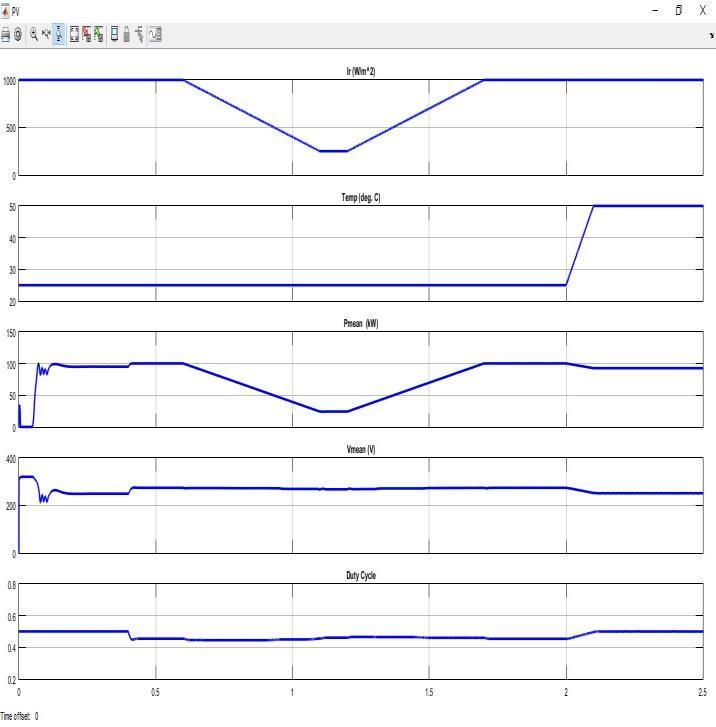
Fig-2: VariableIrradiance,VariableTemperature.Mean Power,MeanVoltage,Dutycycleofproposedmodel

International Research Journal of Engineering and Technology (IRJET) e-ISSN:2395-0056
Volume: 11 Issue: 09 | Sep 2024 www.irjet.net p-ISSN:2395-0072
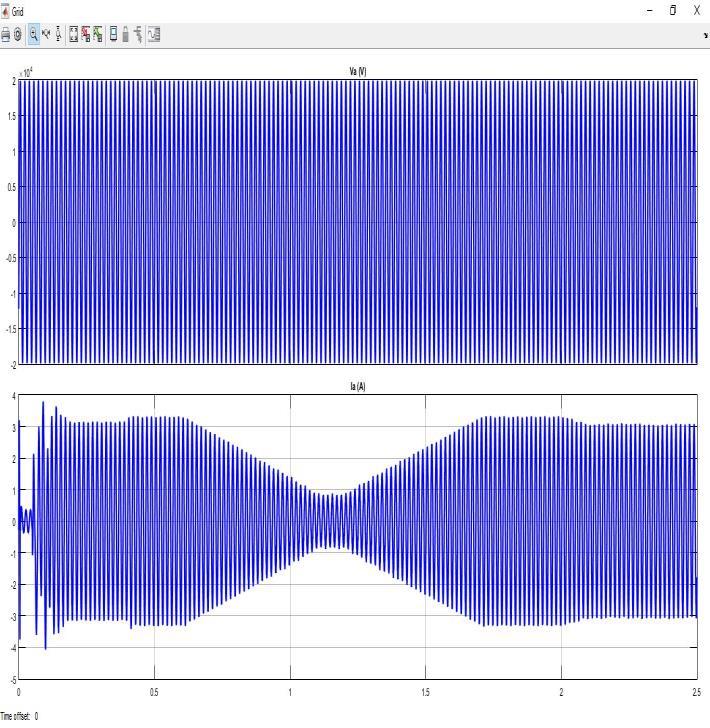
Fig-3: GridVoltageandGridCurrentfortheproposedmodel
The grid voltage maintains constant irrespective fluctuations in temperature and irradiance, as represented bytheprecededfigure.TheTHDinthiscaseis3.29%.
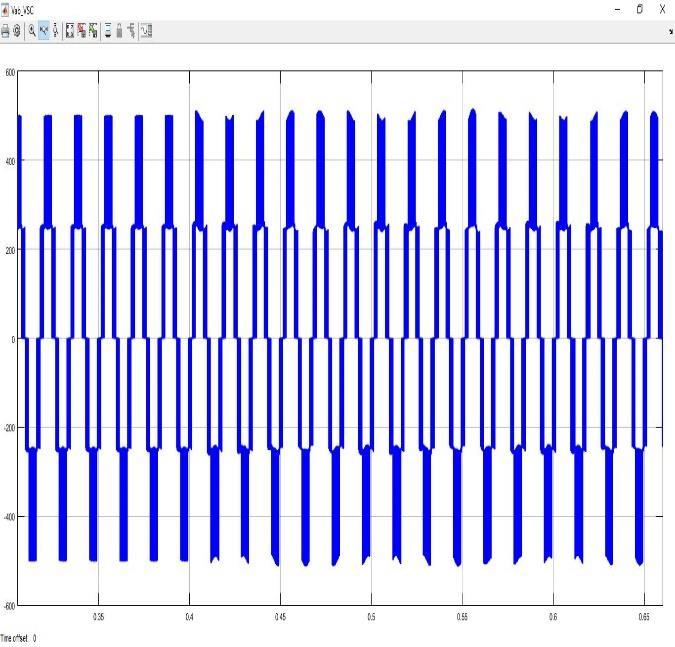
Fig-4: GridConverterOutputVoltage
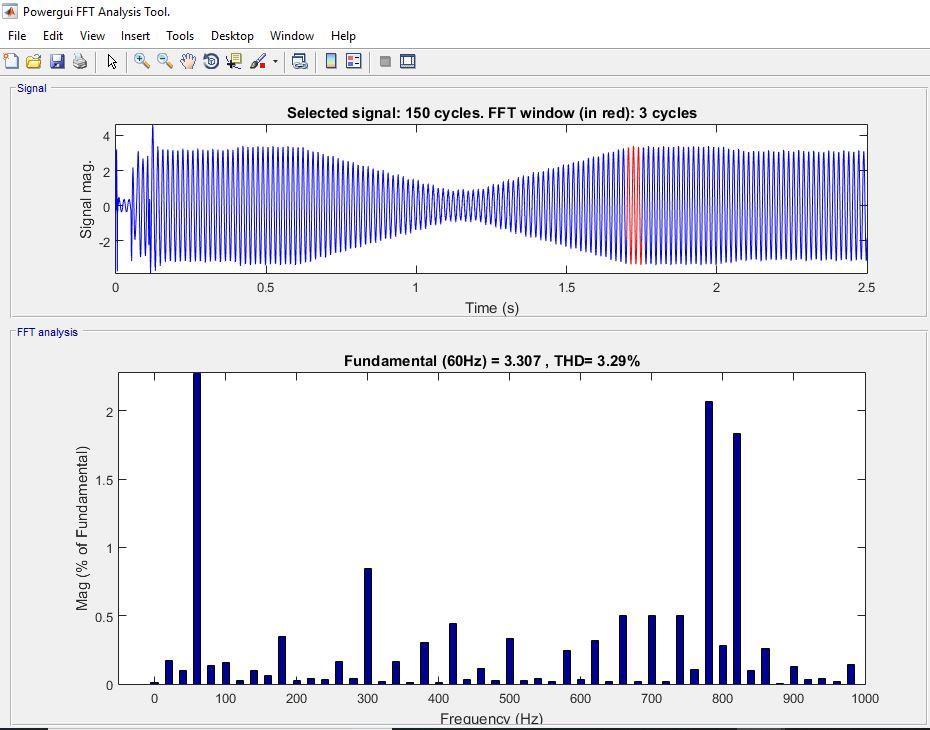
Fig-5: THDanalysisofPSObasedGridConverter
Case 2: GWO based Grid Converter
In this situation, the PI controller's gain values are utilized with the aid of the GWO optimized method. Since the gain valuesaretunedvaluesforthePSOalgorithm,wecanclaim that the controller is tuned by the GWO algorithm since the PI controller produces the optimum output with the aid of the optimized gain value. The matching outcomes are displayedbelow:
The variable temperature and variable irradiance are highlighted in the following figure. Duty cycle, mean power, andmeanvoltage.Thefluctuationsinthemeanpower,mean voltage, and duty cycle exist. The maximum power at 1000 W/m2 and 25 degrees Celsius is 100.7 KW, and the PV module's output power is 273.5 V under those circumstances. The maximum power at 250 W/m2 and 25 degrees Celsius is 24.4 KW, and under these circumstances, the PV module's output power is 265.1 V. The maximum power at 1000 W/m2 and 50 degrees Celsius is 92.9 KW, and under these circumstances, the PV module's output poweris250.2V.

International Research Journal of Engineering and Technology (IRJET) e-ISSN:2395-0056
Volume: 11 Issue: 09 | Sep 2024 www.irjet.net p-ISSN:2395-0072
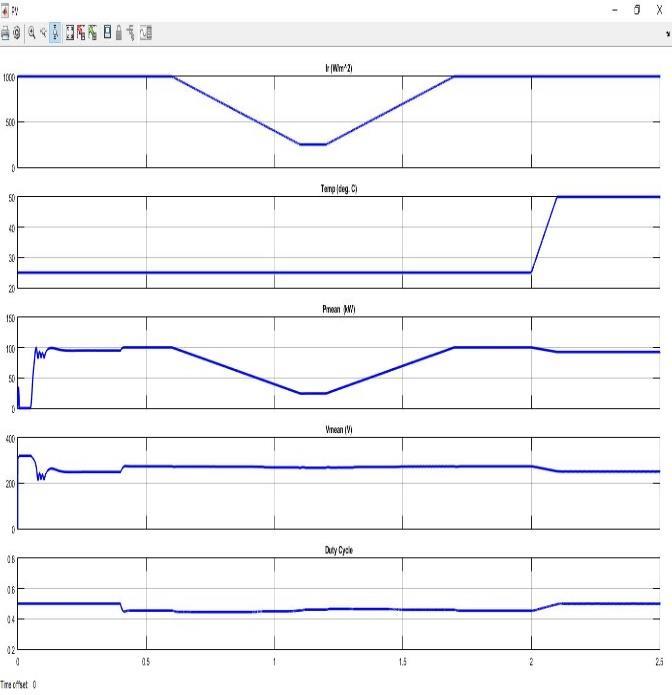
Fig-6: VariableIrradiance,VariableTemperature.Mean Power,MeanVoltage,Dutycycleofproposedmodel.
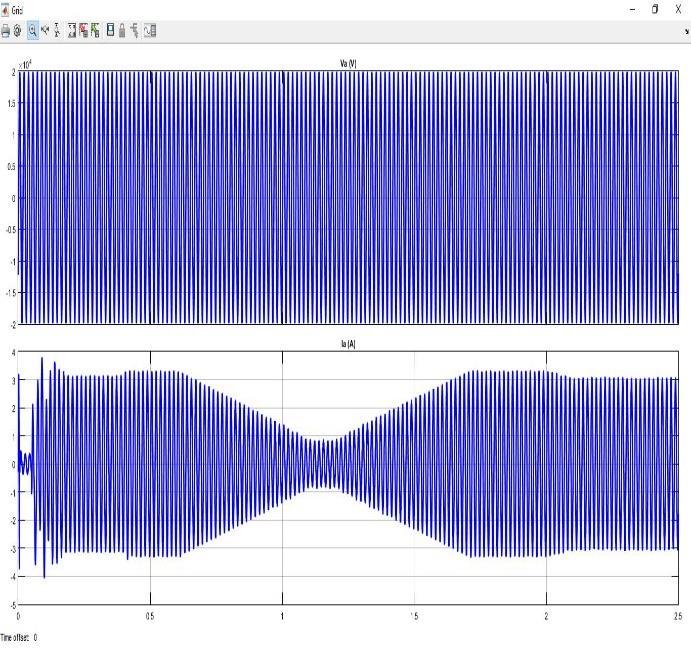
GridVoltageandGridCurrentfortheproposedmodel
Fig-7 shows that grid voltage is constant even though the variableIrradianceandVariableTemperature.
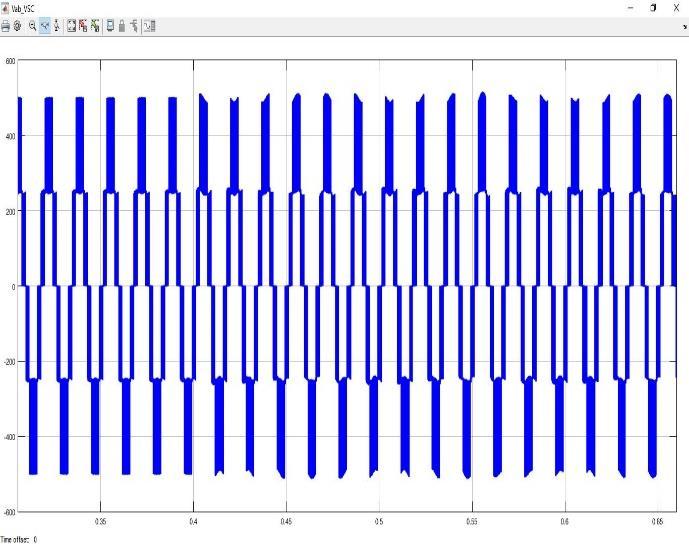
Grid Converter Output Voltage
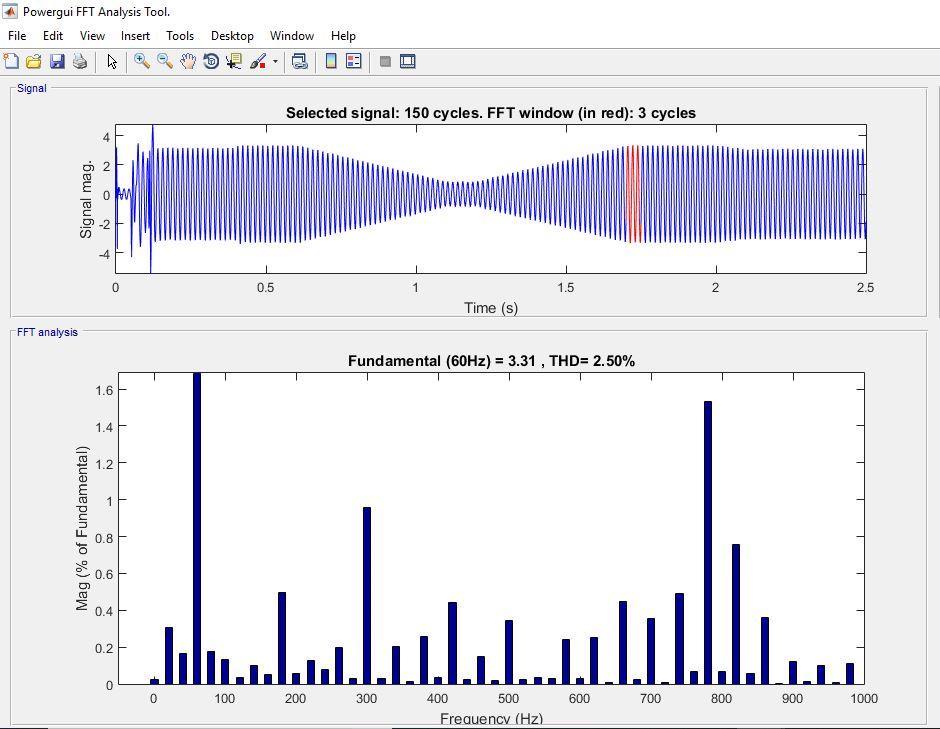
© 2024, IRJET | Impact Factor value: 8.315 | ISO 9001:2008 Certified Journal | Page658

International Research Journal of Engineering and Technology (IRJET)
Volume: 11 Issue: 09 | Sep 2024 www.irjet.net
TheTHDinthiscaseis2.50%.
Table-I: ComparisonofTHD
From the above comparison a mark reduction in THD from 3.29 % to 2.50% is observed with the proposed Grey Wolf Optimized(GWO)basedGridConverter
4.CONCLUSION
In this paper, MATLAB/SIMULINK is implemented to model the Grid Converter based on GWO Tuned PI Controller. The most appropriate tuning technique for the PI Controller, depending on the results, is the Grey Wolf Optimization Technique. It is noticeable from the THD analysis that THD has decreased from 3.29% to 2.50%. Consequently, a Grid Converter'sTHDcanbedecreasedbyimplementingaGWOtunedPIcontrollertoimprovepowerquality.
[1] O. Mahela, A. Shaik and N. Gupta, "A critical review of detection and classification of power quality events", RenewableandSustainableEnergyReviews,vol.41,pp. 495-505,2015.
[2] O. Mahela and A. Shaik, "Power quality improvement in distribution network using DSTATCOM with battery energy storage system", International Journal of ElectricalPower&EnergySystems,vol.83,pp.229-240, 2016.
[3] M. Saini and R. Kapoor, "Classification of power quality events – A review", International Journal of Electrical Power&EnergySystems,vol.43,no.1,pp.11-19,2012
[4] W. Tareen, S. Mekhilef, M. Seyedmahmoudian and B. Horan, "Active power filter (APF) for mitigation of power quality issues in grid integration of wind and photovoltaicenergyconversionsystem",Renewableand SustainableEnergyReviews,vol.70,pp.635-655,2017.
[5] B. Zhou, W. Li, K. Chan, Y. Cao, Y. Kuang, X. Liu and X. Wang, "Smart home energy management systems: Concept, configurations, and scheduling strategies", RenewableandSustainable EnergyReviews,vol.61,pp. 30-40,2016.
[6]K.Muttaqi,A.EsmaeelNezhad,J.AghaeiandV.Ganapathy, "Control issues of distribution system automation in smart grids", Renewable and Sustainable Energy Reviews,vol.37,pp.386-396,2014.
[7] H. Matayoshi, T. Uehara, G. Ludin, A. Sharma, M. Datta and T. Senjyu, "Uninterruptible smart house equipped with a single-phase dq-transformation system", Journal of Renewable and Sustainable Energy, vol. 8, no. 2, p. 025101,2016.
[8] M. Raza, M. Haider, S. Ali, M. Rashid and F. Sharif, "Demand and Response in Smart Grids for Modern Power System", Smart Grid and Renewable Energy, vol. 04,no.02,pp.133-136,2013.
[9] M. Buzdugan and H. Balan, "About power quality monitoring in residential grids", Renewable Energy and PowerQualityJournal,vol.1,no.15,pp.569-574,2017.
[10] I. Riess and A. Leshem, "Odd rectification, hysteresis and quasi switching in solid state devices based on mixed ionic electronic conductors", Solid State Ionics, vol.225,pp.161-165,2012
[11]D.AswathiKrishnaandM.Sindhu,"ApplicationofStatic Synchronous Compensator (STATCOM) to enhance Voltage Profile in IEEE Standard 5 Bus Transmission System", Indian Journal of Science and Technology, vol. 9,no.30,2016.
[12] Z. Rahman and A. Tiwari, "Enhancement of Voltage Profile by Using Static Synchronous Compensator (STATCOM)inPowerSystemNetworks",SAMRIDDHI:A Journal of Physical Sciences, Engineering and Technology,vol.8,no.2,2016.
[13] R. Sundaramoorthy and D. Udhayakumar, "Power Quality Improvement in Modified Solid State Transformer System Using Statcom”, International JournalofEngineeringandComputerScience,2016.
[14] B. Singh, S. Dube and S. Arya, "An improved control algorithm of DSTATCOM for power quality improvement",InternationalJournalofElectricalPower &EnergySystems,vol.64,pp.493-504,2015.
[15] S. Mishra and P. Ray, "Nonlinear modeling and control of a photovoltaic fed improved hybrid DSTATCOM for power quality improvement", International Journal of ElectricalPower&EnergySystems,vol.75,pp.245-254, 2016.

International Research Journal of Engineering and Technology (IRJET) e-ISSN:2395-0056
Volume: 11 Issue: 09 | Sep 2024 www.irjet.net p-ISSN:2395-0072
[16] M. Deben Singh, R. Mehta, A. Singh and W. Meng, "Integrated fuzzy-PI controlled current source converter-based D-STATCOM", Cogent Engineering, vol. 3,no.1,p.1138921,2016.
[17] S. Bouafia, A. Benaissa, S. Barkat and M. Bouzidi, "Second order sliding mode control of three-level fourleg DSTATCOM based on instantaneous symmetrical componentstheory",EnergySystems,2016.
[18]J.Tangaraju,V.Rajagopal andA.Laxmi,"Power Quality Enhancement Using Power Balance Theory Based DSTATCOM", Advances in Electrical and Electronic Engineering,vol.14,no.1,2016.
[19] G. Ramya, V. Ganapathy and P. Suresh, "Power Quality ImprovementUsingMulti-LevelInverterBasedDVRand DSTATCOM Using Neuro-Fuzzy Controller", International Journal of Power Electronics and Drive Systems(IJPEDS),vol.8,no.1,p.316,2017.
[20]F.Belloni,R.Chiumeo,C.GandolfiandA.Villa,"ASeries Compensation Device for the LV Power Quality Improvement", Renewable Energy and Power Quality Journal,vol. 1,no.15,pp.71-76,2017.
BIBIOGRAPHIES

Monika received her BTech degree with Gold-Medal in electronics and communication engineering department from National Institute of Technology (NIT) Jamshedpur, Jharkhand in 2011. In addition, she also received an MS degree in electrical and computer engineering department from National Institute of Singapore (NUS), Singapore in 2016. Currently, she is pursuing a PhD degree in the department of electrical and electronics engineering, Birla InstituteofTechnology(BIT),Mesra,Ranchi,India.Herarea ofinterestincludescontrol systems,model orderreduction, andlarge-scalesystems.
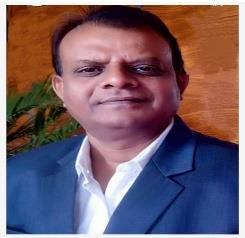
Prof. Umesh Kumar Sinha received his B. Sc. Engineering degree in first class in Electrical Engineering from Muzaffarpur Institute of Technology (MIT) Muzaffarpur, Bihar and M. Sc. Engineering (Power Electronics) form RegionalInstituteofTechnologyJamshedpur,Jharkhandand Ph. D. from National Institute of Technology Jamshedpur (Ranchi University). He had been serving at the National instituteofTechnologyJamshedpursince1996startingasa facultyindesignationLecturerthenAssociateProfessorand at present working as Professor. There are so many publications in reputed Journals (56) and international conferences (28). At present, there are 06 PHD completed undermysupervisionand03maybeawardedthisyearand rest05awardednextyear.
I have worked as HOD, Electrical Engineering Department andhavebeenholdingseveraladministrativepostsassigned by the Director National institute of Technology Jamshedpur. I have evaluated more than 14 Ph. D. theses of different Universities and conducted several Ph. D. VivaVoceExaminations.